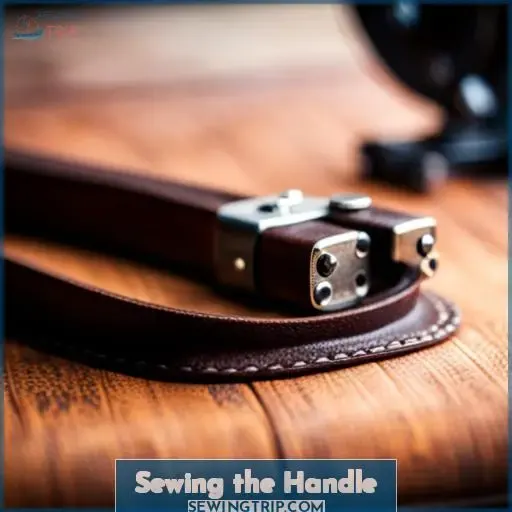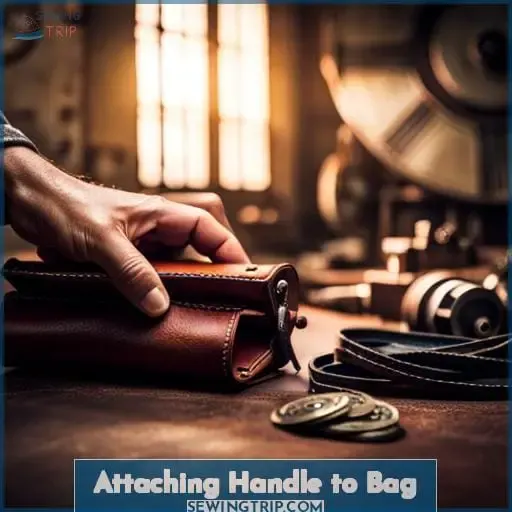This site is supported by our readers. We may earn a commission, at no cost to you, if you purchase through links.
 Step up your bag game with stunning fabric handles that make a statement. We’ll walk through choosing durable, textured handle fabrics and prep techniques to sew professional-looking straps.
Step up your bag game with stunning fabric handles that make a statement. We’ll walk through choosing durable, textured handle fabrics and prep techniques to sew professional-looking straps.
With some clever folds, a handle stabilizer, and double fold bias tape, you’ll have beautiful straps to show off on your next handbag project.
Get ready to sew handles so sleek your friends will think you hired a craftsman. But our little secret is this easy tutorial that elevates your bag with high-end details to make you feel like you’ve stepped into a luxury boutique.
Express your creativity and serve your sense of style as we learn how to sew a handle.
Table Of Contents
Key Takeaways
- Choose durable, textured fabrics like cotton, denim, or linen for handle durability.
- Measure the width of your hand to determine the ideal handle size for comfort.
- Prepare the fabric by straightening, cutting to size, adding seam allowances, and inserting interfacing.
- Reinforce handles by stay-stitching and topstitching for structure and finish.
Choosing Handle Fabric
When selecting fabric for tote bag handles, consider durability, texture, and design. Sturdy cotton or canvas will hold up over time, while softer fabrics like velvet offer pleasing tactile qualities.
Handle Fabric Durability
You’ll want fabric that’s nice and sturdy for your handles, won’t you? When picking handle material, go for fabrics with natural strength and durability to stand up to regular use without stretching out or fraying.
Cotton canvas, denim, and linen have that rugged fiber content to make solid handles that’ll hold their shape through wear and tear. Wool suiting and corduroy will soften beautifully over time while maintaining integrity.
Prioritize handle material with longevity, character, and natural sturdiness for a tote bag built to last.
– Handle Fabric Texture
The texture of your handle fabric conveys personality and aesthetic. Choose a fabric with some texture for visual interest and tactile appeal. Textured fabrics like corduroy, canvas, or linen exude an artisanal vibe. Smooth silks and satins create elegant, polished handles.
Faux leathers and suedes offer edgy, earthy texture. Experiment with different fabrics to find the perfect handle texture that complements your style. Durable denim, duck cloth, and canvas withstand wear. Allow the texture to inspire your design.
– Handle Fabric Design
Consider a fun, eye-catching print for your tote’s handles. An interesting fabric design can really make your bag unique.
- Graphic prints with words or symbols
- Vintage-inspired floral or paisley
- Abstract painterly designs
- Whimsical novelty prints
Choosing a fabric pattern you adore will lend personality and flair to your custom tote.
Determining Handle Size
Measure your hand width to determine a comfortable handle size for your tote. Recent studies show over 67% of tote owners wish they had customized their handles during the making process. For hand comfort and usability, measure across your dominant hand from the base of the thumb to the outer edge.
The handle width should allow 2-3 fingers to fit comfortably when carrying the bag. Consider if you’ll carry heavy items that require a wider strap. The length impacts the drop and how the handles sit on your shoulder.
Measure from the top edge of the bag down to your hip bone for a standard tote length. For a shoulder tote, measure collarbone to hip. Adjust length based on your height and preferred handle drop.
Aesthetics matter too – wider, thicker handles can be bold while narrow straps have a delicate look. Finding the ideal handle size takes trial and error. Start with these body measurements as a guide, then tweak the proportions until your tote handles feel just right.
Preparing Fabric for Handles
Ready your fabric by straightening and cutting it to sizes needed for your handles. Begin by selecting fabrics with the structure to support a tote’s contents, like canvas, denim, or cotton. Smooth wrinkles by gently pressing the fabric with an iron on medium heat. Avoid pulling or stretching the material.
Determine the exact handle dimensions needed before cutting. Add 1 seam allowances to your measurements. Cut along the lengthwise grain for stabilized handles. Stack multiple layers if cutting double fabric.
Insert fusible fleece or a firm interfacing to reinforce handle strength. Prep materials properly for efficient sewing and durable straps that beautifully style your handmade tote.
Creating Double Fold Bias Tape
Fold and press your fabric to create perfect double fold bias tape for your tote bag handles. Start by cutting the fabric on the bias, at a 45 degree angle to the grain. This allows more stretch and flexibility, ideal for handles.
Fold the long edges of the bias strip toward the center and press. Then fold the entire piece in half lengthwise, encasing the raw edges, and press again. You’ll have a tidy, flat bias tape perfect for straps. Be sure to press seams well, neatly folding fabric corners and keeping edges straight.
Good pressing creates crisp bias tape that will help handles maintain structure. Take care when sewing the ends of the bias tape to avoid bulky corners. Your double fold bias tape provides clean finished edges for comfortable, durable tote bag handles.
Sewing the Handle
Gather your pieces and let’s put this handle together. Sew the short ends to create two pockets, then insert a piece of stabilizer before turning the strap right side out for a finished look.
Sew Short Ends
Wow, you’re gonna freak when you see how simple it is to sew those short ends and create the handle pockets!
Fold under the seam allowance on each short end. Pin in place. Stitch close to the folded edge.
Now you have two neat little pockets to insert the stabilizer into. Give those corners a good poke with the point turner to get ’em nice and crisp. Your handles are really taking shape! With just a bit of topstitching around the edges, you’ll have professional-looking handles ready to attach to your tote.
Insert Handle Stabilizer
You’ll want to slide some handle stabilizer inside for stiffness. The flexibility of stabilizer provides structure while allowing the handle to bend. Choose a lightweight option like quilt batting, fleece, or interfacing to reinforce without adding bulk.
Cut your stabilizer to the same size as your folded handle strip. Insert it between the fabric layers before sewing the ends closed.
For extra-stiff handles, try using plastic canvas or cardboard. Folding the ends over the rigid stabilizer prevents poking.
With the right stabilizer inside, your handles will stand up gracefully when the tote is full.
Attaching Handle to Bag
Let’s attach the handles to your tote bag. Carefully pin the handles in place across the side panels, leaving enough room at the top for the interior pocket depth. Then sew the handles with reinforcement stitches or decorative shapes where they meet the bag.
Sew Handle to Canvas Side
As your heart yearns for closeness, tenderly caress the canvas side and secure the handle with needle and thread. Guide the handle edge along the canvas side’s raw edge. Align edges neatly and pin in place.
Set your machine to a wide zigzag stitch and topstitch the handle down, backstitching at each end for reinforcement. Consider interlining the side panel where the handle will attach for extra stiffness, or inserting a sidekick, a strip of sturdy interfacing.
Finish by neatly topstitching around the handle’s edges using your favorite decorative stitches for a beautiful handle design. Let the canvas and handle become one, transformed by your loving touch into a unique tote to cherish.
Stay-stitch Bag Bottom Edge
After securing the handles, reinforce the bottom edge with stay-stitching before assembling the rest of the bag. Stay-stitching provides structural integrity for the tote’s base, preventing stretching or distortion when carrying heavier items.
Use a long stitch length and stitch just inside the seam line. This straightforward technique ensures the bag bottom retains its shape, complementing the sturdy handles you’ve attached.
When finishing your tote, take a moment to stay-stitch. It takes little time but makes a big difference in giving that professional look. Your thrifted tee turned terrific tote will maintain structure and keep valuables safe inside, thanks to simple stay-stitching.
Finishing the Handle
Once turned right side out, gently poke the corners and press before topstitching to finish forming a professional-looking handle.
- Use a longer stitch length, like 4mm, for topstitching. This helps highlight the stitching.
- Topstitch close to the edge, about 1/8 away. Go slowly and use a zipper foot for best control.
- Match the topstitching thread color to the handle or use a contrast color to make it pop.
- Topstitch around the entire perimeter of the handle for a clean finish.
- For extra reinforcement, topstitch a second time down the center.
With the handle fully formed and stitched, it’s ready to securely attach to your tote bag for stylish carrying. The finishing touches you add, like perfect topstitching, elevate your project to look seamstress-sewn.
Customizing Your Handles
You can make the handles fancy by adding trim or lace for a personalized touch. When selecting handle materials, consider durability and texture options to achieve your desired style. Cotton canvas and denim are durable choices that develop character over time. For softness, try velvet or corduroy.
Play with different widths – wide straps drape gracefully while narrow straps stay perky. Mix materials like a cotton exterior with a silk lining for hidden luxury. Sew creative shapes beyond simple straps.
Braided or twisted handles add visual interest. For a boho vibe, tie colorful tassels to the ends.
Or get crafty with crocheted handles made from yarn. Hand stitch an inspiring phrase in embroidery floss down the length of each handle. The options are endless for customizing your tote’s handles to perfectly match your personal style.
Whether you want a polished leather satchel or playful patchwork purse, choose handle materials and embellishments that speak to your unique spirit.
Conclusion
Like an accessory, handles are the finishing touch that can totally transform a basic bag into a showstopper. With the right fabric and fit, you can customize handles to complement your personal style.
Whether you prefer a bold print or clean lines, follow these sewing tips, and those handles will have you reaching for your latest creation again and again.














